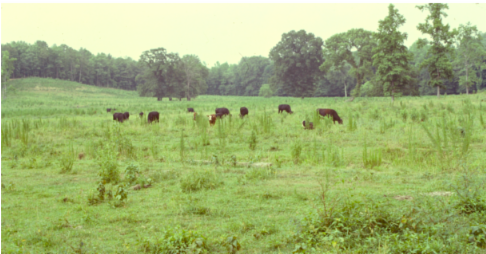
WEEDS IN FORAGE CROPS

Weeds rank as one of the major factors that limit productivity of forage crops. Perhaps the best definition of a weed is simply “a plant out of place.” Most hayfields, and especially most pastures, contain many plant species that are out of place and are unwanted. Weeds compete with desirable plants for nutrients, moisture, sunlight, and space.
In row crops, weeds have no redeeming value, but in forage crops some weeds make a contribution, which sometimes can be fairly significant. On a pound-for-pound basis, some weeds actually provide better nutrition (energy and/or protein) than many of the forage crops with which they compete. However, weeds are almost invariably low yielders, and often are unpalatable, have thorns, or may even be toxic. Make no mistake about it; the overall impact of weeds in forage crops is negative (otherwise we wouldn’t call them weeds!).
The old saying “an ounce of prevention is worth a pound of cure” has much application to weeds in forage crops. Keeping weeds from getting started on a farm or in a field is the first line of defense. Weeds come from seed, so preventing introduction of seed, or preventing them from making seed that would allow them to spread is important. Making certain not to purchase forage crop seed that contains weed seed, killing unwanted weeds when the first few plants are observed on the farm, and avoiding feeding hay containing seed of undesirable species are examples of steps that can be effective.
The more intensively a stand of forage crops is managed, the less likely it is that weeds will be a serious problem. Applying lime and fertilizer according to soil test recommendations increases the competitiveness of forage crops. Also, many weeds have a low tolerance to being grazed, so pasture rotation or altering stocking rates to ensure consumption of weeds by grazing animals can force animals to graze weeds while providing rest for desirable plants. Either grazing or clipping can reduce or eliminate seed production by weeds.
Herbicides can be used to control weeds in many situations. Keys to effective use of herbicides are: (1) using a product that is effective against the specific weed(s) present; (2) treating at the proper time, in particular when weeds are small and actively growing and the temperature is suitable for application of the herbicide to be used; and (3) using the correct herbicide rate.
Most herbicides are applied as a liquid spray, but in some situations in which the height of the target weed(s) is/are significantly higher than the forage crop being invaded, the use of a “roller wiper” can be quite effective (johnsongrass in a bermudagrass hayfield is a good example). The applicator device features a carpet-like roller that is kept saturated with herbicide. As the carpet turns, the herbicide is wiped on the weeds without touching the lower-growing forage crops.
The cost of applying a herbicide varies of course, but is usually in the range of $10 to $20 per acre. In many situations, getting just a few hundred additional pounds of forage per acre will more than pay for the cost of applying a herbicide. Interestingly, it is usually cheaper (as well as much more effective) to apply a herbicide to control weeds than it is to mow a field. Herbicide options are limited in situations where clovers or other legumes are being grown or are to be grown, so it is best to get weeds under control before planting legumes.
__________________
Foraging Ahead is a column presented by Ragan & Massey and written by Dr. Don Ball, Professor Emeritus at Auburn University. Dr. Ball is one of the authors of the popular book “Southern Forages.”